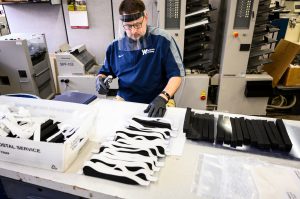
The Office of Business Engagement (OBE) is often considered the “front door” to UW–Madison by connecting businesses with the university’s diverse community of resources, research and innovators. Managing Director John Garnetti sees OBE’s role as one that extends beyond the front door, helping foster meaningful, long-lasting partnerships between the university and industry.
In this follow-up interview, Garnetti discusses UW–Madison’s impact on the growing tech sector in Wisconsin; the increased focus on equity, diversity and inclusion and sustainability in the business community; and the evolution of OBE.

We’ve talked about large businesses and small businesses. Now let’s look at Madison’s tech sector, which has been growing at an exponential rate. It’s getting a lot of attention with how many businesses are coming to Madison and how many startups come out of the city. Here on campus, the Computer Sciences Department, part of the School of Computer, Data and Information Sciences (CDIS), has seen an 800% increase in declared majors over the past 10 years.
How has UW–Madison been a part of this boom? And more specifically, what role does OBE play with the tech sector and the growing industry in Madison?
The university undoubtedly plays a role in the overall growth and boom of the tech sector here in Madison. The latest impact study shows the university has roughly a $30.8 billion economic impact on the state. That’s an incredible contribution in and of itself, but what tends to go unnoticed is that roughly a third of that—$10 billion—is in UW–Madison-related startup activity. Whether it is one of the more famous startups that spun out directly from the university, or it’s a student or faculty whose work or research began while they were at UW–Madison, $10 billion of that activity is related to the university.
Beyond the university, the startup community that’s exploding here in Madison creates a virtuous cycle, an atmosphere and ecosystem of innovation, and greater intellectual capital and sharing of ideas. That kind of spontaneous interaction and collaboration is what you see in some of the great tech sectors and startup communities worldwide, like Silicon Valley or the medical tech sector in Boston. Here in Madison, the university has a critical role in being a part of that ecosystem
So, what role does OBE then play in sustaining that center of gravity? Well, we need to make sure that we see that boom continue for as long as it is sustainable. It’s important that we see sustainable growth within the region, and we [OBE] can and will continue to treat that sustained growth of the tech sector in the community as a priority. This ties directly into the overarching, guiding principle of the university, which is the Wisconsin Idea. And this is one way in which the university and OBE can promote the Wisconsin Idea. The question was around the Madison tech sector, but this same approach applies to the broader Wisconsin tech sector and bringing in and fostering innovation across Wisconsin and bringing corporate partners into that discussion in a way that is coordinated.
We’ve seen a lot of uncertainty and changes taking place in different industries due to the pandemic. UW–Madison stepped up to provide needed resources, from helping small businesses navigate changing policies to the development and fulfillment of much-needed personal protective equipment for hospitals around the country. What are some of the main areas where businesses are looking for help? Are there new opportunities emerging from the pandemic?

Six months into the role, my hands-on experience around this is limited, but that in some ways also gives me an objective, outsider perspective. The university has received a lot of praise for its COVID response, and rightfully so with how it addressed the issue on campus, making its learning and activities safe for students, faculty, staff, and others, as well as how they’ve contributed to the statewide response and a broader global response.
Some of the lessons we should learn from the university’s response is: How do we apply these best practices? We have corporate partners asking us, “How can I replicate this success? Is there a means for me to replicate the best practice or even collaborate with the university to implement some of these programs?”
Students in our School of Computer, Data & Information Science developed COVID-19 dashboards to identify the real-time trends of positive test results to help us track and keep our population safe. Working with students and faculty in that same capacity to provide the tools and technology in an appropriate fashion for our corporate partners is a fantastic opportunity that can benefit all parties, so long as the conversation is structured in a way that is mutually beneficial to the parties involved.
Some other new opportunities that emerged, separate from COVID-19, are issues of equity and broad generational challenges which have come to the forefront. There’s much greater awareness within the general public, but certainly in our business community, of these issues. Any conversation that we have with a partner, whether it’s an internal partner on campus, a big corporation, or a small startup, the topics which always resonate as priority objectives are improving diversity, equity, and inclusion (DEI) and sustainability or ESG (environment, social, governance) issues. These are ubiquitous. They span all sectors, and all scale and scope of business.
From my experience, all parties are approaching these issues with the best intentions. They want to do what they can and they want to learn from each other. Corporate partners are coming together to learn from each other. Academic partners are coming together to learn from each other. And academic and corporate partners are coming together in one room with students and faculty to learn from each other to really address these big issues that don’t have simple solutions. Specific to DEI and ESG, these are areas in which, we’re really focusing our efforts at OBE, not just because it’s the right thing to do, which it is, but because it’s broadly recognized as a necessity.
It is huge. And more individuals and companies are talking about these really important issues.
OBE is mindful of that. And OBE is really taking a hard look at how we can help to foster solutions and be a partner to all in those areas specifically.
What are some things about UW–Madison or OBE that potential business partners might not know about the university. We’ve talked about the five verticals, but what are some facts that a potential partner looking to work with the university might be interested in?
I was born in the Midwest but spent a lot of time outside of the Midwest. I’m glad to come home. I’m fortunate that I’m able to raise my family here because I believe in Midwestern values, first and foremost, Midwestern humility. Having said all that, our Midwestern humility sometimes prevents us from really promoting the incredible work that’s taking place on our campus. We should scream it from the rooftops, even though it goes against our nature to do so. There’s nothing wrong with sharing all the incredible, positive activity that’s taking place here at UW–Madison.
I’ve previously talked about the $10 billion startup impact and the nearly $31 billion in direct and indirect impact to the state, which is completely in line with the Wisconsin Idea that our activity extends beyond the borders of this campus. I am proud to share that impact and the number of world-changing activities happening at the university with anyone who’s willing to listen.
As managing director of OBE, what are some of your top priorities? Are you looking to make any changes to how OBE works with businesses? And if we take a step back, what do you envision the office looking like, in a year from now, in three and five years from now?

Well, I’ll take that last part of the question first. One of the first things I did in the role was get the team together and have deep, open discussion about our vision, our mission, our objectives, and ask, who are we? What is our identity? Where do we want to be? What is our crowning achievement a year from now, three years from now, five years from now? And how do we encapsulate that in a real aspirational vision and a clear mission for the office? The vision that we set out for ourselves is for OBE to be a best-in-class organization within five years. In 2026, we can talk about how UW–Madison has been widely recognized among its peer groups as a leader in the field of university-business engagement. It’s a daunting challenge, but it’s a meaningful one.
In order to realize that vision, we need to institute change, and focus on where we can enact positive change – change for change’s sake is not what any of us are after. Positive change is expanding the team to ensure a greater diversity of experience and thought. To bring together people from outside academia, the private sector, as well as people who have spent time primarily within a university setting to be the voice of the student and the faculty.
I truly want OBE to embody that dual advocate role for industry and university when we are working with our corporate partners and our partners on campus.
In framing these long-term comprehensive relationships, we really have to internalize the needs, the desire, the priorities, and the objectives of each one of our stakeholders, so that we’re accurately and faithfully representing them. And then, of course, you will always need to have continual improvement around operational things like processes and just the mechanics of the job. But what’s most important is that we recognize whatever activity we’re engaged in with our partners, it’s our responsibility to maximize the return on investment for all parties, and we do that through ensuring the framework of the partnership is explicitly designed to achieve mutually beneficial shared outcomes.